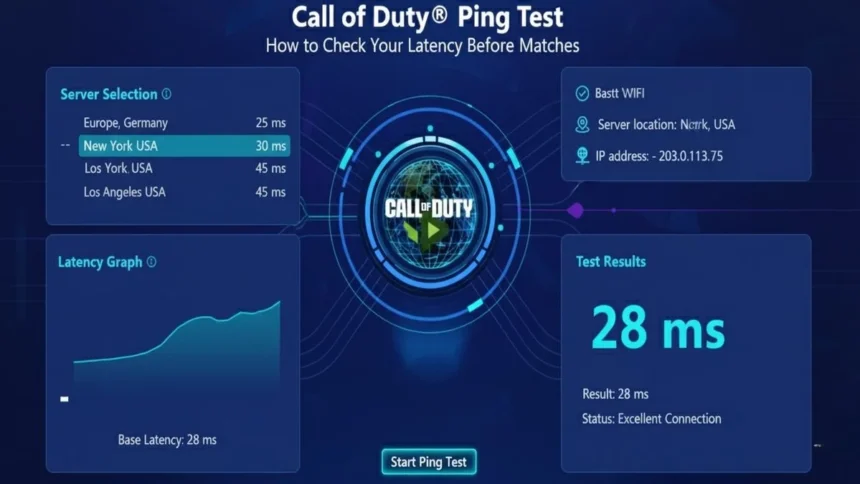Understanding Why Ping Matters in Call of Duty
When it comes to competitive shooters like Call of Duty, every millisecond counts. The responsiveness of your connection directly affects how quickly your actions register on the server, and that determines whether you outshoot your opponent or fall behind. Ping is the measure of this responsiveness, often displayed in milliseconds, and it tells you how long it takes for your computer to communicate with the game server.
- Understanding Why Ping Matters in Call of Duty
- What is a Call of Duty Ping Test
- The Impact of Call of Duty High Ping on Gameplay
- Simple Ways to Run a Call of Duty Ping Test
- Why Call of Duty High Ping Happens
- How to Troubleshoot High Ping After Testing
- The Role of Game Servers in Ping Results
- How to Interpret Ping Test Results
- Improving Consistency in Ping for Call of Duty
- Preparing for Matches with a Ping Test
- Final Thoughts on Call of Duty Ping Tests
A lower ping generally means smoother gameplay, quicker reactions, and more reliable outcomes in firefights. Many players underestimate the importance of checking ping before matches, but it is a critical step for anyone who wants a consistent and competitive experience. Running a Call of Duty ping test is the most effective way to know what you can expect before loading into a match.
What is a Call of Duty Ping Test
A Call of Duty ping test is a method of checking your connection to the game servers to measure latency. This test essentially sends small packets of data from your device to the server and records how long it takes for them to travel back and forth. The resulting number, measured in milliseconds, is your ping. When you have a low ping, your movements, shots, and in-game decisions sync with the server nearly instantly. On the other hand, if you have a high ping, there is a delay between your input and what happens in the game, which can create a frustrating and unfair gaming experience. Running this test before entering a match helps you determine whether you are ready to play competitively or if you need to adjust your connection.
The Impact of Call of Duty High Ping on Gameplay
Experiencing Call of Duty high ping is one of the biggest frustrations for online players. High ping means your connection to the server is delayed, and that can cause several noticeable issues. One of the most common problems is rubberbanding, where your character suddenly snaps back to a previous location because the server did not register your movements correctly.
Another issue is delayed shooting, where you fire at an enemy, but the server processes your action too late, resulting in a missed opportunity. In competitive matches, high ping puts you at a disadvantage because your enemies with lower ping will always have faster reactions in the server’s eyes. Even if you are highly skilled, consistent lag will undermine your ability to perform well. This is why testing your ping is not just a technical step but a vital part of preparing for smooth gameplay.
Simple Ways to Run a Call of Duty Ping Test
There are several ways to run a Call of Duty ping test, ranging from built-in features to third-party tools. One of the simplest methods is to check your ping in the game’s own network settings or multiplayer lobby, where latency is often displayed. This gives you a quick snapshot of your current connection. Another option is to use online ping testers specifically designed for gaming. These tools connect to the closest Call of Duty servers and give you a precise measurement of latency. You can also run a ping test directly from your computer by using command prompt tools, though this requires knowing the correct server IP addresses. Each method provides valuable insights, and combining them ensures you have the most accurate picture of your connection before matches.
Why Call of Duty High Ping Happens
Understanding why you experience Call of Duty high ping is essential if you want to fix it. Several factors can contribute to high latency. One of the most common causes is server distance, meaning the game has matched you with a server far away from your physical location. Another frequent issue is network congestion, either on your home Wi-Fi or through your internet service provider, which slows down your data packets. Running too many background apps, streaming, or downloads while gaming can also increase ping. Additionally, outdated hardware such as old routers or poor-quality Ethernet cables can create unnecessary delays. By identifying the root cause of high ping, you can make targeted improvements to ensure more stable gameplay.
How to Troubleshoot High Ping After Testing
Once you run a Call of Duty ping test and find that your latency is higher than acceptable, the next step is to troubleshoot. The simplest fix is to restart your router, which often clears up temporary network issues. Switching from Wi-Fi to a wired Ethernet connection is another effective step since it reduces interference and ensures a more direct connection to your network. Closing unnecessary applications and background processes frees up bandwidth for your game. You can also try adjusting your in-game server region settings to connect to servers closer to your location. If the problem persists, contacting your internet service provider for assistance or considering a higher-speed plan may be necessary.
The Role of Game Servers in Ping Results
Not all ping issues come from your personal setup. Sometimes the problem lies with the game servers themselves. Even if you have a strong internet connection, overloaded or unstable servers can cause high ping and lag during matches. This is particularly common during peak play hours or after new updates, when large numbers of players flood the servers. Running a Call of Duty ping test before starting a match can help you identify whether the issue is on your end or the server’s side. If multiple players report high ping during the same time, the servers are likely to blame, and patience may be the only solution until the developers stabilize performance.
How to Interpret Ping Test Results
Running a ping test is only the first step; interpreting the results is equally important. A ping below 50ms is considered excellent and usually results in very smooth gameplay. Anything between 50ms and 100ms is still playable but may have minor delays noticeable to competitive players. A ping between 100ms and 150ms begins to create obvious lag, and anything above 150ms is usually problematic, leading to major delays, rubberbanding, and hit registration issues. By knowing what your numbers mean, you can make informed decisions about whether to proceed with matches or troubleshoot further before playing.
Improving Consistency in Ping for Call of Duty
While lowering ping is the ultimate goal, consistency is just as important. Even if your ping is moderately high, a stable connection ensures predictable gameplay. The real problem occurs when ping fluctuates dramatically during a match, creating unpredictable delays. To improve consistency, always use a wired connection when possible, limit background internet usage in your household, and make sure your router is positioned in an optimal location. Updating router firmware and keeping your system drivers current can also reduce fluctuations. When you run your Call of Duty ping test regularly, you can track whether your connection is steady and identify problems before they escalate.
Preparing for Matches with a Ping Test
Running a Call of Duty ping test should become a regular part of your routine before starting matches. Think of it as a pre-game warmup that ensures your equipment and environment are ready. Just as professional athletes check their gear before stepping onto the field, gamers benefit from knowing their network conditions before competing. By testing latency first, you can avoid frustrating surprises mid-match, especially if you are playing ranked modes or competitive tournaments. Preparing with a ping test helps you approach each game with confidence, knowing your performance will depend more on skill than technical limitations.
Final Thoughts on Call of Duty Ping Tests
In fast-paced games like Call of Duty, milliseconds can be the deciding factor between winning and losing. Running a Call of Duty ping test is an essential step for anyone serious about their gameplay experience. By understanding what ping is, how it affects performance, and what steps to take when latency is high, players can ensure smoother matches and fewer frustrations. Call of Duty high ping will always be a challenge, but with the right knowledge and tools, it can be managed and minimized. Consistency, preparation, and proactive testing make all the difference, helping you enjoy the game as it was meant to be played.





